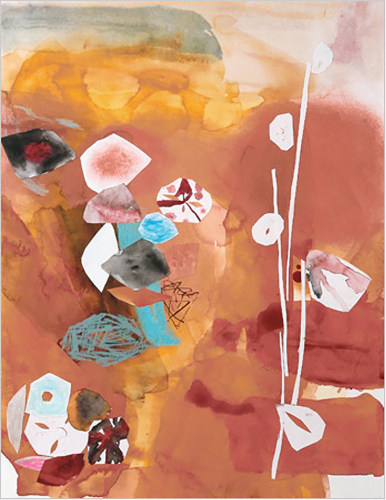
Two artists who draw their inspiration from Long Island’s East End are the subject of a lovely if uneven exhibition at the Spanierman Gallery in East Hampton. The problem is in the pairing of the artists, one of whom is a lot more interesting than the other.
The two artists are Mary Abbott and Sally Egbert. Both work within the Abstract Expressionist tradition, making lyrical, colorful and intuitive works using a variety of media. The visual resemblance between their pictures is uncanny.
But where Ms. Abbott’s works reveal a well-honed eye for composition, structure, form and surface texture, Ms. Egbert’s, especially her recent, often large oil paintings, feel empty and unresolved. It is tempting to think of them as unfinished.
Maybe it is an issue of scale. Many of Ms. Egbert’s paintings seem too big for what she has to say, which is fairly modest. The strength of her works is in the intimate relationships of blocky shapes of color and the way they interact within ambiguous spaces, all of which gets a little lost on a large scale.
To get a sense of this you might compare an oil painting like “Twilight” (2001) with some of Ms. Egbert’s much smaller — and to my mind, infinitely more successful — mixed-media collages, works like “Moon Flowers” (2008) or “Orange Radiance” (2008). The collages have a greater intensity, even a kind of athleticism, about them.
Ms. Egbert, who was born in Bay Shore in 1958 and lives in East Hampton, seems to be interested in moments of transitional light, when the landscape can appear indistinct and abstract. It is extremely difficult to convey this solely in paint, which may also account for the greater success of her collages.
Yet Ms. Egbert is an extremely skilled colorist with a talent for dramatic lighting. “Local Sky” (2008) and “White Pine” (2008), two of her better oils, capture moments in which light is shifting and time appears to stand still. “White Pine,” in particular, seems to be more focused and resolved than the others.
Ms. Abbott presents an altogether different kettle of fish. Born in New York in 1921, she began visiting the East End in her youth and has been living there part of the year since 1966. In that time she has refined her sweeping, energetic brushstrokes to capture brilliantly personal responses to the local landscape and the changing light.
Works showing here like “Bill’s Painting” (circa 1951), “Beginning” (1950) and “Untitled” (circa 1951) may not seem all that different from paintings by Ms. Egbert. But look closely and you will begin to notice the greater attention to brushwork, paint application and layering, along with the color combinations. These are seductive compositions.
This is no surprise, for Ms. Abbott studied with Mark Rothko, Barnett Newman and Robert Motherwell. She had great teachers. She also knew and was influenced by Willem de Kooning, to whom “Bill’s Painting” is dedicated. The painting’s mix of calligraphic marks and broadly lathered brushstrokes echoes de Kooning’s style.
But what I especially love about this painting is the color scheme — loosely brushed pinks in varying tones mixed with black, blue, white and a hint of orange and yellow at the top and sides. It is so unusual, with the layering hinting at some primal energy bubbling up beneath. The clash of surface colors also keeps your eyes jumping.
Other paintings are positively hyperactive. “Untitled (Haiti)” (1950), a mass of squiggly lines and biomorphic shapes, can put you in mind of the early work of Jackson Pollock, which makes sense given that Ms. Abbott socialized with him in the 1940s at the Cedar Tavern, the artists’ hangout in Greenwich Village.
To see this and other early works by Ms. Abbott together is a treat, for most come from private collections and have rarely been publicly shown. Few of her works are on permanent display in New York-area museums. That is a shame, for she is one of the last great Abstract Expressionist painters of her generation.
-by Benjamin Genocchio